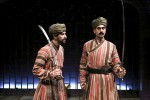For actor Ramiz Monsef, being hit with a metal folding chair in a previous role was mentally and physically less taxing than his part as Babur in “Guards at the Taj.”
Opening Oct. 14 at the Geffen Playhouse, the play balances comedy and tragedy as it tells the story of two ordinary guards protecting the recently completed Taj Mahal.
Set in the 17th century, “Guards at the Taj” explores the relationship between the two guards, conservative Humayun, played by Raffi Barsoumian, and mischievous dreamer Babur. It also brings to life one of the mythical stories surrounding the construction of the famous monument.
Director Giovanna Sardelli said this is the twelfth show she has done in collaboration with the play’s writer, Rajiv Joseph. Because she wasn’t directing the world premiere, she said she initially didn’t read the script until Joseph called and asked her to read it overnight.
“I didn’t (read it) because I was busy and then I got the call to direct it, said yes and then sat down and read it,” Sardelli said. “He’d been talking about it for two years and I was in love with the play – I couldn’t read it before because I knew it would hurt too much if I knew I wouldn’t be able to tell the story.”
Barsoumian said the play focuses on the love between the two best friends and how that relationship is strained. The guards find a brotherhood because of the similarities they share such as their appreciation of the Taj Mahal’s beauty, he said.
“It’s interesting how they digress from each other; there are certain influences in each of their lives that make them think differently, even though I think they’re friends because they share (similarities in) certain things,” Barsoumian said.
Sardelli said the ideas “Guards at the Taj” explores force the actors to leave their hearts and souls on the stage. Because of their relationship, she said whenever she threw ideas or questions at the two actors, they were able to bring them to life.
Having recently worked together at the Oregon Shakespeare Festival, Monsef said he and Barsoumian have a brotherly relationship, just like the two Taj Mahal guards in the play.
“It is kind of perfectly cast since I’m like Babur – I’m definitely more of a dreamer with his head in the clouds, and a troublemaker,” Monsef said. “And Raffi is a cowardly nerd, so it’s perfect.”
Barsoumian said the modern language contemporizes the antique setting and further allows the audience to connect with the world and characters.
“It’s set in India, but it’s just a very human play and is really looking at these two characters that are two very different sides of the human psyche,” Barsoumian said.
In addition to focusing on the brotherhood between Babur and Humayun, Sardelli said “Guards at the Taj” poses questions concerning the consequences and cost of beauty.
To coax the audience into the world of the play and allow the actors to work freely, the set was created to be open and expansive, she said.
“We tried to keep it simple and let the audience bring their imagination to the story as well because when you’re talking about what’s aesthetically pleasing, what’s beauty, what’s frightening, we want them engaged,” Sardelli said.
With the use of contemporary English, Monsef said he hopes the audience will be able to just see the characters as human beings.
“The thing I look for in art of any kind is seeing if it speaks to humanity and if it’s something that can bring a room full of people together to share an experience,” Monsef said. “Everyone who comes to see this play will go through something, and we’re going to go through it with them as we take them on a journey.”
